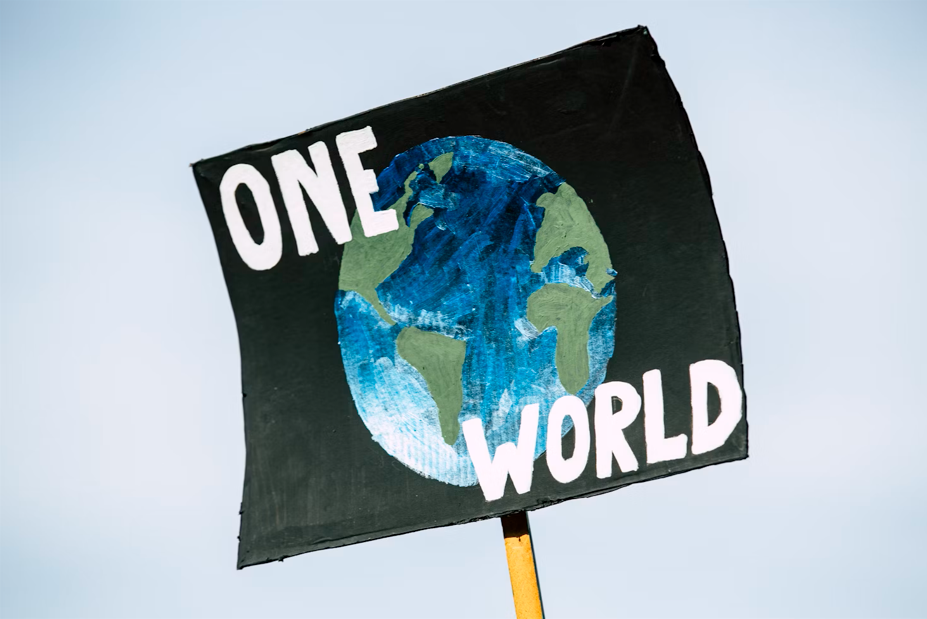Aarushi Mahajan, Sarabel Odero, V S Bharadwaj, Anil Tamsoy
Introduction
Climate change, although a global challenge, often imposes a dual problem on developing nations where the need for economic growth often conflicts with a move towards environmental sustainability. Today, major emerging economies such as those of India, Brazil, and South Africa are confronting difficult trade-offs owing to their heavy reliance on carbon-intensive industries, such as agriculture, coal, and manufacturing which complicates their efforts to reduce emissions and embrace sustainable measures. Additionally, such a shift towards sustainability often involves significant economic costs such as the disruption of traditional industries, which in turn leads to a slowing GDP growth and the creation of short-term job losses.
This article aims to examine the economic implications of climate change and climate policies introduced to mitigate this change. The analysis ultimately underscores the need for strategic investments, effective policy frameworks, and international cooperation to help these nations achieve climate goals without compromising their economic development.
India
As of 2024, India is the nation responsible for one-third of global emissions annually per capita. By avoiding carbon-intensive activities, it has set an example for economic development in emerging economies. Eleven years ahead of the 2030 deadline, it has already met the Nationally Determined Contributions (NDC) target of reducing emission intensity (Mohapatra, 2024). The proper separation of GDP growth rate and greenhouse emissions is a sign of sustainable development (Ministry of Finance, 2024). India has committed to using 50% of its installed capacity for electricity generation from non-fossil fuels by 2030 (Government of India, 2022).
Sectoral Analysis
As of May 2024, the non-fossil power capacity for the energy sector stands at 45.4%. The energy demand is expected to go up by double or triple times because of the increasing energy demands by the growing economy, especially the cement and steel industries (UNDP, 2024). To fulfil the sustainable energy objectives, India needs to increase renewable energy investments (Prasad, 2024).
By 2047, India aims to eliminate energy poverty and energy objectives through a people-centred strategy (Chowdhary, 2024). Additionally, particularly in the wake of the Paris Agreement, India’s climate policies have shown to be quite effective and successful (Wahengbam, 2024). Reducing emission intensity is on track to meet the NDC Goal 3 of reducing overall emission intensity by 33–35% from 2005 (Vishwanathan et al., 2023).
The Climate Compatible Development (CCD) scenarios for India predicted a 0.8% loss in Indian GDP in 2030 and a 1.1%–1.8% decline in 2050 because of the aggressive push for climate policies. However, India’s NDC targets and net-zero action plans may coexist with healthy economic growth, provided the implications of climate change on population health and well-being are taken into account. On the other hand, this effect will cause global employment to decline by 0.5% in 2030 and by 1% in 2050. However, jobs lost in fossil fuel industries will be offset by the jobs created by the renewable energy sector supplemented by specialized retraining programs (Vishwanathan et al., 2023).
Climate Finance
One of the key results of COP29 was the agreement to increase the climate finance for developing nations from USD 100 billion to 300 billion by 2035 under the New Collective Quantified Goal (NCQG) (UNFCCC, 2024). India set an annual goal of USD 1.3 trillion for the NCQG to support it, with USD 600 billion coming from grants or similar funds. The nation expressed concerns about the allocation and deficiency of climate funding, particularly the need for poor nations (Desk, 2024).
Public-private partnerships (PPPs) allow the government to allocate funds for sustainable development from corporate and other income taxes. This financing will translate into new energy infrastructure by facilitating the transfer of knowledge, capital, technology and skills from the private to the public sector (Trivedi, 2023). The Green Climate Fund (GFC) highlights the significance of concentrating climate finance on the rural sector, where low-emission development and adaptation measures are desperately needed (Grants From Green Climate Fund, 2024).
Brazil
Brazil, as one of the largest economies in Latin America, is deeply impacted by climate change, with deforestation posing the biggest threat to key sectors of the country’s economy. Brazil’s economic vulnerability stems from its dependence on agriculture, hydropower and natural resources. The agricultural sector – vital for domestic food security and international exports – is especially vulnerable to droughts and temperature extremes that damage crops and reduce water availability for irrigation. Similarly, the energy sector, which relies heavily on hydropower, faces risks from reduced water availability and fluctuating rainfall patterns. The World Bank estimates that extreme weather events have led to an annual output loss of 0.13% of GDP in Brazil over the past 20 years (“The Economics of Climate Change in Brazil,” n.d.).
Deforestation, particularly in the Amazon rainforest, exacerbates Brazil’s vulnerability to climate change. The destruction of this critical ecosystem not only disrupts water cycles but also threatens to push the Amazon to a tipping point, with severe consequences for the climate system. The Amazon’s collapse could reduce Brazil’s GDP by as much as 10% by 2050, with profound effects on agriculture, hydropower, and industry (Giz, 2024). Given that the Amazon plays a crucial role in carbon sequestration, its degradation also undermines global efforts to mitigate climate change.
In response to these challenges, Brazil has developed and begun to implement a national climate policy. Since ratifying the Paris Agreement in 2016, Brazil has committed to reducing its greenhouse emissions by 50% in 2030, to achieve climate neutrality by 2050 (Chen et al., 2024). This ambitious agenda requires a comprehensive restructuring of national climate governance and a series of policy initiatives.
Brazil’s national climate policy is built on several key areas, including enhancing transparency, climate finance and green growth. A monitoring system to track the impacts and progress of its Nationally Determined Contributions (NDCs) is being developed, along with mechanisms to reduce emissions from deforestation and forest degradation (REDD+) (Brazil Climate Change Country Profile | Climate | U.S. Agency for International Development, 2024). These measures aim to support Brazil’s low carbon transition and strengthen its capacity to meet both national and international climate targets. At the subnational level, Brazil is empowering states to align their climate policies with the federal agenda through initiatives such as the development of a Federal Programme for Environmental Services and the implementation of a green growth strategy.
Brazil’s climate change policies, while essential for long-term sustainability, are expected to impose significant short- and medium-term economic challenges. According to a study done by Econmia do Climia, climate change itself could result in a reduction of the country’s GDP by up to 2.5% by 2050, equivalent to a loss of between R$ 719 billion and R$ 3.6 trillion, depending on the severity of the climate scenario (“The Economics of Climate Change in Brazil,” n.d.). This represents a potential loss of at least an entire year of economic growth over the next 40 years.
The cost of adaptation and mitigation efforts, such as investment in renewable energy, deforestation reduction, and agricultural adjustments, could also strain national resources. For instance, the Brazilian government may need to invest R$ 1 billion annually in agricultural research and up to USD 51 billion in expanding energy capacity to meet demand in a changing climate (“Ensuring Greener Economic Growth for Brazil,” 2017). Moreover, policies such as carbon taxation or increased regulations on emissions may have a direct economic impact, reducing GDP by approximately 0.13% to 0.08%, with a corresponding increase in operational costs for businesses, particularly in high-emission industries.
In the long term, however, these climate policies are likely to lead to a more resilient and diversified economy, particularly as Brazil capitalizes on its renewable energy potential and mitigates deforestation. Nonetheless, the transition to a low-carbon economy will require careful management of these economic trade-offs to avoid exacerbating existing vulnerabilities.
South Africa
As one of the largest carbon emitters in Africa due to its reliance on coal for electricity generation, South Africa must navigate the tension between fostering economic growth and achieving environmental sustainability.
South Africa’s energy sector accounts for nearly 80% of its greenhouse gas emissions, with Eskom, the state-owned utility, heavily dependent on coal (World Bank, 2023). COP 2025 emphasized the global commitment to net-zero emissions, pushing South Africa to accelerate its transition to renewable energy sources. Initiatives like the Just Energy Transition Partnership (JETP), supported by $8.5 billion from international donors, present opportunities for infrastructure development and foreign investment. However, the transition requires substantial financial resources, estimated at over $250 billion by 2050, straining an economy already burdened by a high fiscal deficit (National Treasury, 2024).
Renewable energy adoption promises long-term cost savings, as solar and wind energy become increasingly cost-competitive. Additionally, reducing reliance on imported fuels can improve energy security and stabilize electricity costs. However, upfront investment in technology and infrastructure poses short-term economic risks, potentially impacting national debt levels.
The energy transition is a double-edged sword for South Africa’s labour market. The coal industry employs approximately 120,000 workers, many in regions like Mpumalanga, where livelihoods depend on coal mining (Statistics South Africa, 2024). Climate policies necessitating coal plant closures risk exacerbating unemployment, which already stands at 32% (IMF, 2024). Addressing this challenge requires robust reskilling programs and investment in alternative industries to absorb displaced workers.
Conversely, the renewable energy sector offers significant job creation potential. The International Renewable Energy Agency (IRENA) estimates that South Africa could generate up to 250,000 jobs by 2030 in solar, wind, and related sectors (IRENA, 2023). Investments in green industries, such as electric vehicle manufacturing and sustainable agriculture, could further diversify the economy. Effective implementation of these policies will determine whether South Africa realizes these employment gains.
Climate policies also influence South Africa’s global competitiveness. The European Union’s Carbon Border Adjustment Mechanism (CBAM), effective in 2026, will impose tariffs on carbon-intensive imports, potentially impacting South African exports such as steel and aluminum (European Commission, 2023). Aligning with international climate standards can preserve access to critical markets, but requires investment in decarbonizing industrial processes.
Moreover, leveraging its abundant resources of critical minerals like platinum and lithium positions South Africa as a leader in the global green economy. Developing these industries can enhance export revenues and attract foreign direct investment, offsetting the economic costs of transitioning from fossil fuels.
South Africa’s climate policies under COP 2025 present significant economic implications, requiring a delicate balance between environmental goals and socio-economic realities. While renewable energy adoption and green industry development offer opportunities for growth and job creation, managing the transition’s costs and ensuring social equity remain critical. International support, effective policy design, and strategic investments will be key to mitigating risks and unlocking South Africa’s potential in the global green economy.
Discussion
India, Brazil, and South Africa, despite being three different nations on three different continents, each with its own complex economies, still grapple with common challenges when it comes to balancing economic growth and environmental sustainability. Each country’s approach to climate policies reflects its economic structure, energy dependence, and socio-political priorities.
As a country 11 years early on meeting the NCD target of reducing emission intensity, India’s aggressive climate policies can offset the economy by a GDP loss of 0.8% by 2030 and 1.1% — 1.8% by 2050 with a decline in global employment of and 1.1% — 1.8% by 2050. South Africa suffers from a similar conundrum with its transmission from coal to renewable resources costing it a staggering deficit of $250 billion by 2025. Keeping aside the impact of the transition in the long term, the short-term financial risks cannot be turned a blind eye to. Workers around 120,000 would be thrown off their jobs, significantly impacting global employment. Brazil, along with greenhouse gas emissions also primarily deals with the issue of deforestation. The potential collapse of the Amazon rainforest could further reduce GDP by up to 10% by 2050, severely affecting agriculture, hydropower, and industry, while also undermining global climate mitigation efforts. Policies like carbon taxation could also impact GDP and increase operational costs for businesses.
One common solution that the three countries can bank upon for their similar problems in dealing with the economic costs of their climate policies is the rise of the renewable sector. The employment that can be generated by the renewable sector will certainly help push the decline in global employment. The renewable energy sector can generate 250,000 jobs by 2030 in South Africa. The increase in climate finance from $100 billion to $300 billion for developing countries at COP29 under the New Collective Quantified Goal (NCQG) adds several helping hands in covering the huge costs although India pushed for a $1.3 trillion aid, expressing concerns over the adequacy of funds for poorer countries.
Conclusion
It can be concluded that for developing countries, it is indeed an intricate challenge to implement climate policies while navigating through heavy trade-offs with their economies. Investments in renewable energy can prove to be very costly in the short term. India requires careful job management and displacement while South Africa’s dependence on coal presents significant hurdles, but the shift to renewable energy promises long-term benefits, including job creation and enhanced energy security. Brazil’s ambitious climate goals and policies, including deforestation reduction and a low-carbon transition, seek to mitigate potential economic losses but require substantial investment and careful economic restructuring. Effective policy design, international cooperation, and strategic investments will be essential in achieving their climate goals while sustaining economic growth and social welfare.
References
Brazil climate change Country profile | Climate | U.S. Agency for International Development. (2024, November 1). U.S. Agency For International Development. https://www.usaid.gov/climate/country-profiles/brazil
Chen, C., Kirabaeva, K., Kolerus, C., Parry, I. W., & Vernon, N. (2024). Changing climate in Brazil: key vulnerabilities and opportunities. IMF eLibrary. https://doi.org/10.5089/9798400289361.001.A001
Chowdhary, V. (2024, October 1). India’s Clean Energy Transition Requires a Delicate Balancing Act. The Diplomat. https://thediplomat.com/2024/10/indias-clean-energy-transition-requires-a-delicate-balancing-act/
Desk, O. (2024, November 15). Developed countries need to provide at least $1.3 tn annually till 2030, India suggests at CoP29 Baku. ETGovernment.com. https://government.economictimes.indiatimes.com/news/policy/developed-countries-need-to-provide-at-least-1-3-tn-annually-till-2030-india-suggests-at-cop29-baku/115331543
Ensuring Greener Economic Growth for Brazil: Opportunities for Meeting Brazil’s Nationally Determined Contribution and Stimulating Growth for a Low Carbon Economy. (2017). In Climate Policy Initiative. https://climatepolicyinitiative.org/wp-content/uploads/2018/12/BID-Ensuring-Greener-Economic-Growth-for-Brazil.pdf
Giz. (2024, October 28). Shaping a successful climate policy in Brazil. giz.de. https://www.giz.de/en/worldwide/126099.html
Government of India. (2022). India’s updated first nationally determined contribution under Paris Agreement (2021-2030). In Submission to UNFCCC (pp. 1–3). https://unfccc.int/sites/default/files/NDC/2022-08/India%20Updated%20First%20Nationally%20Determined%20Contrib.pdf
Grants from Green Climate Fund. (2024, August 8). https://pib.gov.in/PressReleaseIframePage.aspx?PRID=2043003
Khan, S. A. R., Ponce, P., & Yu, Z. (2021, November 15). Technological innovation and environmental taxes toward a carbon-free economy: An empirical study in the context of COP-21. – Journal of environmental management. https://www.sciencedirect.com/science/article/abs/pii/S0301479721014808
Luo, J., Ali, S. A., Aziz, B., Aljarba, A., Akeel, H., & Hanif, I. (2023, January). Impact of natural resource rents and economic growth on environmental degradation in the context of COP-26: Evidence from low-income, middle-income, and high-income Asian countries. – Resources Policy. https://www.sciencedirect.com/science/article/abs/pii/S030142072200712
Ministry of Finance. (2024, July 22). DESPITE BEING ONE OF THE FASTEST-GROWING ECONOMIES IN THE WORLD, INDIA’S ANNUAL PER CAPITA CARBON EMISSION IS ONLY ABOUT ONE-THIRD OF THE GLOBAL AVERAGE. pib.gov.in/. https://pib.gov.in/PressReleasePage.aspx?PRID=2034915
Mohapatra, S. (2024, July 24). Economic Survey 2023-24: India Challenges Global Climate Strategy, Calls for Equitable approach. Frontline. https://frontline.thehindu.com/environment/economy-policy-india-climate-strategy-rethink-balancing-growth-sustainability-economic-survey-2024/article68440598.ece
Prasad, R. P. (2024, July 22). Energy needs to grow 2.5 times but green power faces hurdles: Economic Survey 2023-24. Moneycontrol. https://www.moneycontrol.com/news/business/economy/energy-needs-to-grow-2-5-times-but-green-power-faces-hurdles-economic-survey-2023-24-12774812.html#google_vignette
Roe, A.R. (2024, November 27). Climate change and poorer economies: some reflections after COPs 27
and 28. – Mineral Economics.
https://doi.org/10.1007/s13563-024-00476-5
The economics of climate change in Brazil. (n.d.). In The Economics of Climate Change in Brazil. https://unfccc.int/files/adaptation/application/pdf/brazil_climateeconomy_executive_summary.pdf
Trivedi, D. L. S. &. D. (2023, January 30). Public-Private partnership in solar energy: Indian perspective. IJPIEL. https://ijpiel.com/index.php/2023/01/30/public-private-partnership-in-solar-energy-indian-perspective/
UNDP. (2024, November 11). What’s cooking at COP 29 this year? https://www.undp.org/india/stories/whats-cooking-cop-29-year
UNFCCC. (2024, November 24). COP29 UN Climate Conference agrees to triple finance to developing countries, protecting lives and livelihoods. Unfccc.int. https://unfccc.int/news/cop29-un-climate-conference-agrees-to-triple-finance-to-developing-countries-protecting-lives-and
Vishwanathan, S. S., Fragkos, P., Fragkiadakis, K., & Garg, A. (2023). Assessing enhanced NDC and climate compatible development pathways for India. Energy Strategy Reviews, 49, 101152. https://doi.org/10.1016/j.esr.2023.101152
Wahengbam, T. (2024, March 14). India’s climate diplomacy: New priorities and policy options – CSEP. CSEP – Centre for Social and Economic Progress. https://csep.org/policy-brief/indias-climate-diplomacy-new-priorities-and-policy-options/
European Commission. (2023). Carbon Border Adjustment Mechanism (CBAM). https://ec.europa.eu
IMF. (2024). World Economic Outlook: South Africa.
International Renewable Energy Agency (IRENA). (2023). Renewable Energy and Jobs Annual Review 2023.
National Treasury. (2024). South Africa Budget Review.
Statistics South Africa. (2024). Quarterly Labour Force Survey.
World Bank. (2023). South Africa Energy Transition Report.






